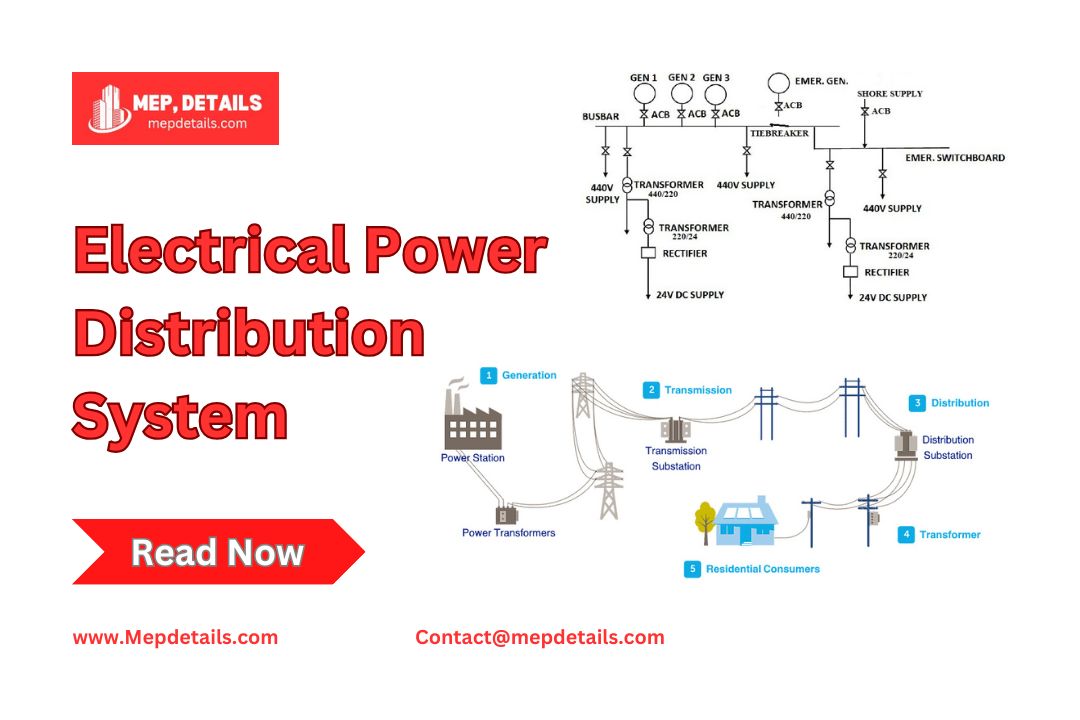An electrical power distribution system delivers electricity from power sources, like power plants, directly to consumers, including homes, businesses, and factories. Its main role is to supply power with the right voltage, current, and frequency to meet user demand efficiently, safely, and reliably at a fair cost. Key parts of the system, such as transformers, switchgear, feeders, distribution lines, and panel boards, work together to ensure smooth power flow from generation to the end user. This article explains the electrical power distribution system, covering its components, operation, types, and common challenges.
What is an Electrical Distribution System?
An electrical distribution system consists of components that deliver electricity from high-voltage transmission systems to consumers at utilization voltages. It bridges the gap between the power generation/transmission systems and the point of consumption. A distribution substation is an important component in the electrical power distribution system. It steps down high-voltage electricity from transmission lines to lower voltages suitable for distribution. This process involves transformers that reduce voltage levels, ensuring safety and compatibility with residential and commercial usage.
Components of an Electrical Power Distribution System
Distribution Substation
A distribution substation is a key part of the electrical system that takes power from the transmission system and lowers the voltage using transformers. It steps down high voltages, like 133kV, to medium levels, such as 11kV, to serve different distribution feeders. A typical substation includes switchgear, busbars, transformers, protection relays, and metering equipment. It supplies power to several feeders connected to distribution lines.
Feeders
Feeders are the main lines that carry medium-voltage power from the substation, either directly or through distribution transformers, to customers over long distances. Also known as distribution mains, they supply multiple branches (laterals) that deliver power directly to consumers, including large industrial loads that may have dedicated feeders. Feeders connect the substation to various areas in the distribution network and are designed to handle high volumes of power, ensuring consistent voltage levels across the area.
Distribution Transformers
Distribution transformers lower the medium voltage from feeders to a level suitable for homes, businesses, and small industries. These transformers usually reduce voltage from around 440kV or 33kV down to 240V or 220V. You can find them on poles, pads, or in underground vaults near where electricity is needed.
Distributor Conductors
Distributor conductors carry the low-voltage power from distribution transformers to consumers. These conductors are typically overhead lines or underground cables made of aluminum or copper. They follow a “tree wire” configuration for single-phase lateral supplies, handling specific current loads and ensuring safe delivery to residential and commercial areas.
Service Mains Conductors
Service mains conductors bring electricity from the distributor conductor to the customer’s meter. They are also known as the service drop or service lateral. A service disconnect near the utility connection point protects these conductors, which provide homes and businesses with a stable power supply at the needed voltage and current.
Classification of Power Distribution Systems
Power distribution systems use either AC (alternating current) or DC (direct current).
AC Distribution Systems
- Primary Distribution: Primary distribution carries electric power at medium voltages (33kV to 11kV) from substations through overhead lines or underground cables, called feeders. These feeders deliver electricity to commercial loads or to transformers that serve homes. Voltage regulation devices keep voltage stable across long distances, making this stage key for maintaining voltage levels and minimizing losses.
- Secondary Distribution: Secondary distribution further reduces voltage from medium (33kV to 11kV) to lower levels (240/220V) for consumer use. This part of the system may use different layouts (radial, loop, or network) based on the area’s load density. Secondary distribution delivers electricity from transformers to homes and businesses, ensuring safe, usable voltage levels.
Typical Voltage Levels:
- Single-phase: 230V
- Three-phase: 400V
DC Distribution System
In DC systems, current flows in one constant direction, avoiding the periodic reversals seen in AC. DC has minimal skin effect, especially at low frequencies, and works well with battery-based energy storage.
Conclusion
A strong and efficient electrical power distribution system is key to providing uninterrupted electricity to all users. As cities grow and consumption patterns change, managing and maintaining distribution networks brings both technical and economic challenges. Modern upgrades focus on making the system more reliable, resilient, and sustainable by adding renewable energy, using digital tools, and increasing flexibility.
FAQs
What is distribution in an electrical power system?
The distribution system is the part of an electric system that delivers electricity from the transmission system directly to consumers, marking the final stage in delivering electric power.
What are the four types of power distribution systems?
The four main types of power distribution systems are radial (a simple feeder setup), parallel feeders (which offer higher reliability but cost more), ring main (similar in reliability to parallel feeders), and meshed systems.
What is the basic concept of electric power distribution?
Electric power distribution involves generating power at a station, transmitting it through transmission lines, and using a distribution network to deliver it to end-users, either through overhead lines or underground cables.
What are the three types of electric power distribution?
The three basic types of electric power distribution systems are radial, loop, and network, which can be used individually or in combination.
Read More – Zig-Zag Transformer: Everything You Need to Know
